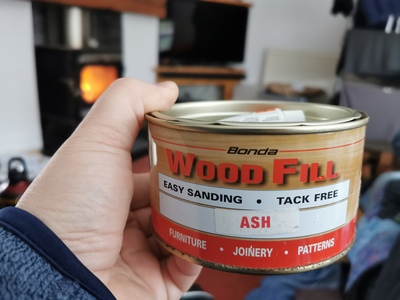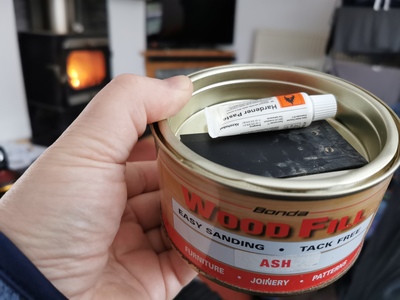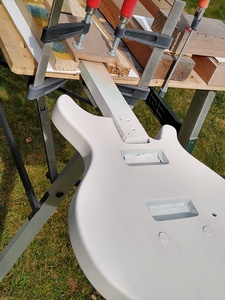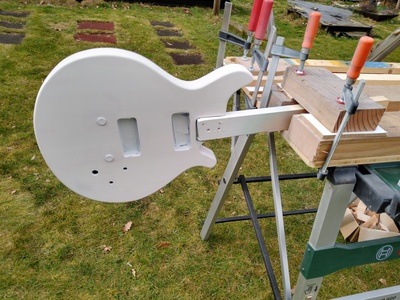"dedication and patience" are absolutely essential for spraying.
@tv101 That’s it, you just have to accept that it’s a long and drawn out process that is repetitive and tedious. What makes it bearable is the quality of the finish when it’s all done, that’s what keeps me motivated to do all the prep work properly, as mind numbing as it can be.
Make guitars, not war 🌍✌️🎸
A rubber eraser makes for a good sanding block for finer grit sandpaper to fix imperfections. Very forgivable even when pressure is applied. I admire you all for such a process to commit to. Results of which turn out splendid. Someday, not nowhere near soon I will attempt such finishing. Digging the body shape @koendb. Looks very comfy modern classic shape. It could pass as aguitar from the 70’s or the present time. Cannot wait for the completed unvailing.
Any little imperfection in the bare wood will always show through.
Stop, fill, sand and start again.Any little imperfection in the primer coats will always show through.
Stop, fill, sand and start again.Any little imperfection in the colour coats will always show through.
Stop, fill, sand and start again.Any little imperfections in the top coats will always show through.
Stop, fill, sand and start again.
@tv101 Doing a spray job is the easy bit.
Treat the preparation work and the paintwork as separate jobs.
In Guitar building we have various types of jobs to do, bandsaw, routing, laminating, drilling, sanding etc. All of these are broken down into small jobs to complete those respected sections of the build.
For example, routing the truss rod slot is broken down into several small jobs to enable it to be done. If we leave out the conversation about buying prepared neck blanks etc as apposed to buying wood and attempting to prep it yourself and assume the blank is flat, that is the first step. It then has to be marked out with a centre line and for the length, with and depth of the slot. With the correct router bit installed in the router, we then set the fence to the correct distance on the router to the edge of the blank. Then clamp a couple of stops at either end so the router bit cannot cut further than is required. So all of these little things you have to do to get the job done, they are all in “preparation” for the channel to be cut. It’s all preparation work for the actual cut, installation of constraints. The router is dumb, it only knows how to do one thing, spin a sharp cutter to cut whatever is in front of it. So it has to be constrained, harnessed, guided, respected, tamed etc. The clamps, the fence, the stops, the depth gauge, it’s all “preparation” for the actual thing you are trying to accomplish. The cutting is the easy bit, the preparation is the hard bit that takes longer. Check twice, cut once. If the router is left to its own devices, it will chose the path of least resistance and randomly wonder all over the place and cause major problems.
Spraying a guitar (or anything) is the easy part (ish). The filling, sanding, finniting, priming, sanding, cleaning, repeat, repeat, repeat is all preparation and should be treated as a separate stage than spraying paint. Yes it’s all part of the “finishing” stage but it’s separate to the actual application of spraying paint. They are intrinsically connected but not the same thing. I wouldn’t even start to think about getting the paint out, whether it be rattle cans or spray guns, until the preparation stage had been done. It’s very easy to get excited about getting paint on to your project and it can make you cut corners or do sloppy prep work, just because you are eager to get the paint on. You must resist this force, painting is a separate stage once the preparation stage is completed.
We can compare the all of the products used in the paint preparation stage to the router prep stage, they are all there for a reason, to make the actual event of routing and spray painting easy. The router will cut where it has been told to go and the paint will stick to the smooth surface you have laid out for it. This principle applies across every stage of the build or anything in life if you really think about it. You plan and prepare the ground for whatever you can before you do it if you want something to work properly and have the maximum potential for success. There is no guarantee of absolute perfection and no amount of planning will ever go 100% smoothly but planning and preparation narrows the margin of error.
Sometimes being all hung ho and doing things in an ad hoc fashion can have some surprisingly good results, other times you can plan a proper sequence of events and it turn out bad. This can happen in painting, you have good experiences and bad ones too, it can be heartbreaking but overall, the good times out way the bad.
Right, I’ve rambled on for far too long, I need to get some work done now. Where is that Bandsman I was building? It’s time to sand that grain filler down, Aquacoat by the way is such a wonderful product but that is another conversation. 👍
Make guitars, not war 🌍✌️🎸
A rubber eraser makes for a good sanding block for finer grit sandpaper to fix imperfections. Very forgivable even when pressure is applied. I admire you all for such a process to commit to. Results of which turn out splendid. Someday, not nowhere near soon I will attempt such finishing.
@clinton Yes a rubber eraser is a great thing to use as a sanding block, sometimes you need a bit of flexibility (literally). Various grades of sanding block stiffness/softness are available to buy but we can get by with household items and wood off cuts etc. Choosing the right one for the appropriate job is the way to go. A flat hard one or a soft curved one and all in between.
Make guitars, not war 🌍✌️🎸
Yep it is, however, I will stick with the filler I have now and train my patience
@koendb Are you painting or clear coating the neck for this guitar? You could grain fill that whilst you are waiting for the body to dry.
Make guitars, not war 🌍✌️🎸
Seriously, we all get better because of you and your insights and advice. You seem to cut the doubts and guess work that we all come across.
@clinton Thank you my friend, we are a community here for each other and we are more powerful together than on our own. We are a gestalt entity.
“We are Legion” (Red Dwarf, Legion)
Make guitars, not war 🌍✌️🎸
3 coats of primer today, each with about 1.5 hours in between, lightly sanded with 400 in between just to make sure to remove dust particles and a bit more sanding on two spots that I still found.
Again I managed to get some runout at the back of the upper horn with my first coat, while I wanted a very light coat. I still need to work on my spraying technique! Coats 2 and 3 where much better. I used shorter bursts (not even a second I guess), starting off the body, move more quickly over the body and out again on the other side. This seems to have worked better and more focussed then my previous attempts.
I ll leave the rest for tomorrow, see If I need to go back, or can move forward. I hope the weather stays OK 🙂
Is it adviceable to do successive days of painting? or can I leave it , say for a week, and come back to it to proceed? Or in other words: does it matter that the nitro is already half way cured when you want to apply another coat?
Is it adviceable to do successive days of painting? or can I leave it , say for a week, and come back to it to proceed? Or in other words: does it matter that the nitro is already half way cured when you want to apply another coat?
@koendb Looking good. I would try and continue to get it all done if you can. If the weather doesn’t allow, you will have to wait unless you have an indoor space you can use. Nitro is one of those paints that actually melts together when you spray new paint onto old paint so you should be ok to just carry on. Just to be on the safe side, I would key the surface a bit with a scotch pad, not too much though, clean it and wipe with a tack rag. Just build the layers up in thin coats and try not to get any runs. The tip I gave you the other day about putting the rattle cans in a tub of hot water about 10 mins before you spray is good but it does make the paint a little thinner too. It makes the paint flow better but it’s easier to get runs because it’s become less viscous, so you need to be aware of that.
Make guitars, not war 🌍✌️🎸
If the weather doesn’t allow, you will have to wait unless you have an indoor space you can use. Nitro is one of those paints that actually melts together when you spray new paint onto old paint so you should be ok to just carry on. Just to be on the safe side, I would key the surface a bit with a scotch pad, not too much though, clean it and wipe with a tack rag. Just build the layers up in thin coats and try not to get any runs. The tip I gave you the other day about putting the rattle cans in a tub of hot water about 10 mins before you spray is good but it does make the paint a little thinner too. It makes the paint flow better but it’s easier to get runs because it’s become less viscous, so you need to be aware of that.
@Boo, yeah I dont have an indoor space to do this. I have to do it outside. Thats indeed the reason why I am asking, if the weather turns, I might need to wait another week or more to proceed.
So I guess, it is preferable to continue, but it still is ok to wait because nitro will melt into older layers anyway, is what I am reading?
The runouts are really because I apply too much ( going way too slow, hence , buildup in corners ), so now I just use really short strokes, or bursts and just do it multiple times, which gives the same result, but no runouts as a result since I do it that way.
in between coats I indeed use scotch pads, got them in 3 different versions ( white, red and dark grey ), I also use 400 on a cork block or on stewmac fret erasers, which makes good sanding blocks 🙂
I really appreciate and value the time you take on these various finishing threads to share your knowledge and give us all the guidance from your experience.
Big thanks from me, mate.
👍
Online guitar making courses – guitarmaking.co.uk
Can’t argue with that 👍🏻
I have too many guitars...said no one in the world..ever!
If you have to stop spraying and continue later it’s a good idea before you start again in earnest to first give it a mist coat which is a very light coat. This will “warm up” the previous coats of lacquer (that have been curing) without shocking them due to it being a smaller amount of lacquer. Does that make sense? I think I ate too much and now I can’t write properly...
Practice on scrap...







